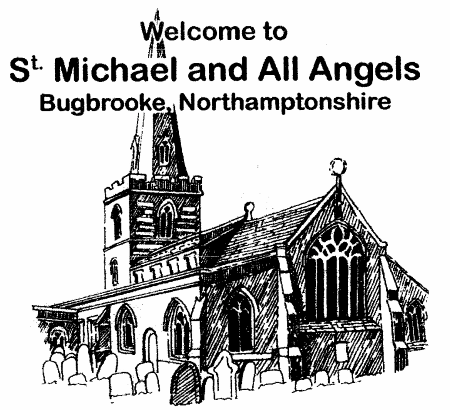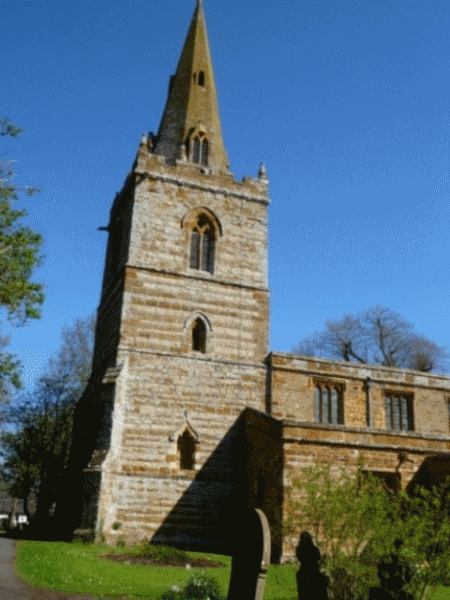A brief guide to our Church and village...

The first documentary evidence for the existence of Bugbrooke
is the Domesday Book of 1086, although there is no reference
to there being a church then.
The first record suggesting a church is when a rector
was instituted in 1220.
It would have looked quite different then with the stone walls
covered with brightly coloured paintings on plaster illustrating
the scriptures.
These would have been whitewashed later as a consequence
of the Reformation, and the plaster finally removed during the
early twentieth Century.
The 750th anniversary of the founding of a church in Bugbrooke was celebrated in 1970.
The church is built of marlstone, a form of sandstone interspersed with ironstone.
Originally the church was dedicated to the Assumption of Our Lady, later to become St.Mary's.
It was not until the 19th cenury that the dedication of St.Michael and All Angels was established.
Nave and Aisles
The original church consisted of a broad nave of four bays, together with the chancel.
An aisle was added to the south side of the nave (the right hand side when facing the altar) about 1225.
This is the oldest visible part of the building.
The south aisle piers are round and it is suggested that they may have been reused from another building
as they are out of proportion with the arches they support.
The arcade leans outwards, suggesting that the original roof was very heavy.
The north aisle was built about 50 years later.
Note that the piers are octagonal and are more evenly spaced than those on the south aisle.
The north choir aisle, now the Lady Chapel, was built afterwards as an extension east-wards of the north aisle.
The aisle to the south of the choir was added in the late 19th
century.
New pews were built and the pulpit installed in the 1890s.
19th Century re-ordering of Bugbrooke Church
In 1828 the old open-ended pews were replaced with box pews which were rented to families in the village,
there were a few pews at the back for poor folk to sit in.
Music was supplied from a gallery at the back of the church and the chancel was bare except for two box pews
for the Rector and his servants.
But modern ideas about styles of worship were reaching Bugbrooke and the first step in 1879 was the purchase
of an organ to replace the instrumentalists in accompanying the singing.
The organ, made in 1844, was purchased from a church in Oxford and was placed where the font now is.
Because of the height of the new organ the gallery had to be taken away.
By now robed choirs had become fashionable and with the Communion Service growing in prominence once again,
moves were set in train to re-order the inside of Bugbrooke church to fit in with the new styles of worship.
A scheme was drawn up by Matthew Holding, who had already drawn the plans for St. Matthew, Northampton
and St. Mary, Far Cotton.
There were two main aims in view, to bring the organ and choir to the front of the church, and to make the altar
the focal point of the church and visible from the majority of seats.
So the scheme proposed the building of an extension to the south aisle which was to incorporate a space
for the organ and a choir vestry, the raising of the east end of the sanctuary as far as was possible without
making the priest's vestry doorway too low, and then, to create even more height for the altar, lowering
the whole of the Nave floor by about a foot all over.
Also incorporated in the plans were a new under-floor hot air heating system and new pews open-ended
more like those replaced in 1828.
The work commenced in June 1890 when the last service in the old church took place and from then on
the services took place in the Sunday School Hall.
The work was hardly finished by Wed. May 8th when the Bishop of Peterborough came for a
special service of re-dedication in what was a very. different looking church inside from the
closure nearly a year before.
It is this centenary that was celebrated with a festival week in 1991.
Further work continued on the church up to the beginning of the First World War and the final debts
were paid off in 1920 in memory of the Rev. Ernest Harrison who had died that year.
In 1998, a new north porch replaced a badly built Victorian one .

Chancel
This was probably always the same size as it is now.
The chancel arch was built around 1270. The roof was designed by E de Wilde Holdings,
who masterminded the 1890s restoration.
The east window is also his.
Screen and font
The chancel screen and font were made about the same time, but it is hard to date them.
They are in perpendicular style, which typified architecture from 1335 to 1530.
The font has had its top half replaced with new stone although the base is original.
The screen would have looked even more magnificent in the 16th century when it
would have been brightly painted with much gilding.
Although the bottom panels were replaced in the Victorian restoration,
the original uprights and carving remain.
The Lady Chapel screen dates from 1911 but the two centre pieces of tracery
are of a much older date.
Tower Arch and Bells
The tower was built in the early 1300s of marlstone and ironstone in strips.
The pinnacles were added about 1890, and the spire is octagonal.
The walls of the ringing chamber are six feet thick.
Note the tablet for bell-ringers discovered under the plaster early this century.
There is a peal of five bells.
The oldest bell bears the inscription "God save our Quene and her presearve 1599".
The tenor was cast in 1695 and its inscription includes the words
"I to the church the living call
and: to the Grave doe summon all".
The other bells were made in 1863, 1868 and 1813 (re-cast 1931).
Parish records
The records of Baptisms, Marriages and Burials are continuous since 1556.
Music
Music had come to Bugbrooke church by 1723!
In the West gallery musicians and singers would lead the congregation in the hymns.
The organ was built by Bishop and Son of London in 1844,
was moved from St Peter in the East, Oxford to Bugbrooke in 1879.
Erected first at the west end, it was moved to the Lady Chapel and then in 1911 re-sited
in its present position.
Stained glass windows
The East Window: This is by far the largest window in the church and it depicts
the Biblical account of the Ascension.
The North Side from the east: Saints Peter and John healing a lame beggar at the
Beautiful Gate of the Temple.
The West Wall: There are two windows either side of the Belfry screen,
each dedicated to the patron saints with which the church has historically been associated.
The Belfry window: St George and Peace.
The Remembrance Window: This shows a sailor and soldier of WWI before the crucified Christ.
Above is the Lamb of God signifying Christ in his sacrificial role.
Poppies - a modern symbol of sacrifice, appear to the upper right and left.
The Village
The name of our village has chanqed over the years.
In the Doomsday Book (1086) it is Buchebroc, going through Buttebroc (1176), Butebroc (1194),
Buddebroc (1195), Bokebrok (1247), Bukbroc (1332), Buckbroke (1428) and at last Bugbrooke in 1598.
The name is usually taken to mean brook of the bucks or goats
(bucca in Latin meaning goat) or of a man called Bucca.
The association with badgers is erroneous but despite this, the badger has become
the emblem of Bugbrooke.
Bugbrooke has always been on or near important communication routes.
Banbury Lane was a prehistoric track way before the Romans built the Watling Street (A5).
Later came the canal (1796), the railway (1832) and the M1 motorway (1959).
Heygates Mill is the headquarters of one of England's largest independent millers.
The first mill on the site was established in AD 800.
In 1086 it was the third highest rated mill in England.
The packhorse "clapper" bridge dates from the 16th century when wool used to be carried
over the Hoarstone Brook by ponies. When the stream was widened in 1970 the last of the ancient pillars
was damaged beyond repair.
The village has been and still is an important centre for non-conformist religion.
In the 17th century Quakerism was popular and many villagers were imprisoned for their beliefs.
The Baptist chapel was built in 1808 and flourished for a century-and-a-half.
Presently the Jesus Fellowship uses the chapel.
Link to the BUBROOKE LINK MAGAZINE for more infomation and Pictures
Compiled from A Brief History and Architectural Description of the Parish Church
of St. Michael & all Angels at Bugbrooke, written by David Peet and
Bugbrooke 2000BC to 2000AD an illustrated history - ancient and modern - Bugbrooke History Society
Notes on the village are taken from Countryside Walks, Bugbrooke, published by Northampton Leisure Services